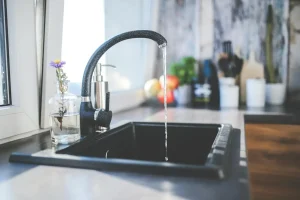
Removing and installing a bathroom faucet is not a tedious job at all.
You only need the right tools and guide to get started.
Table of Contents
ToggleWhat to Prepare Before Installing a Bathroom Faucet Yourself
- Pliers
- Flashlight
- Plumber’s putty
- Thread seal tape
- Phillips and regular screwdrivers
- Adjustable Wrench (or basin wrench)
Steps to Install a Bathroom Faucet Without Calling a Plumber
Important: You can follow the specific instructions from the product manual for your new faucet.
Your faucet manufacturer or brand may have different parts indicated depending on the faucet style.
Follow these steps if you have a widespread faucet type:
Step 1: Turn the water supply off
Turn the shut-off valves off before you begin the new faucet installation.
Once turned off, turn your faucet on to drain the remaining water that is inside the pipes.
Step 2: Disconnect the supply lines under the sink
Note: The supply lines are located under the sink, connecting to the hot and cold handles on the faucet.
Meanwhile, the lift rod is located directly behind the waterspout, which is used to open and shut the sink drain.
Remove the mounting nuts using a basin wrench.
You can see two mounting nuts – one on each side of the faucet.
Once removed, the faucet is now disconnected from any water pipes.
Step 3: Replace the old faucet and clean the sink
Carefully remove the old faucet and be sure not to damage the tubing or pipe.
Run a putty knife around the faucet base to carefully loosen it.
This unseals any caulk and cleans off dirt and sediment build-up.
Note: As you remove the faucet, check the connections and overall hardware. Replace any damaged, corroded, or rusted bolts, piping, or other areas.
Step 4: Install the new faucet
Get a thread seal tape and wrap it around the threads of the faucet where they connect to the lines.
Grease a silicone sealant around the sink holes and where the new deck plate will be placed.
Put the faucet down through the holes in the sink.
Be sure to align the faucet properly.
Then, wipe away any excess silicone residue and make sure that the inside of the basin cabinet is dry and clean.
Step 5: Lock it up
Tighten the mounting nuts with the thicker side up using your hands.
You can use pliers if needed to prevent leakage but do not be sure it’s not too tight.
Step 6: Reconnect the supply lines
Using the adjustable wrench, reconnect the supply lines carefully.
Be sure to connect the correct temperature tubes to the designated handle.
Typically, red-colored tubes are for hot water while blue-colored ones are for cold water.
Check for a label on the supply lines attached to the faucet.
Note: You can wrap the connection points with a plumber’s tape to ensure no leakages.
Step 7: Test your faucet
Finally, turn the water on slowly and assess the tubes and connections for minor leaks.
If you see any water dripping, turn off the valves and tighten the corresponding areas slightly.
Repeat if necessary.




